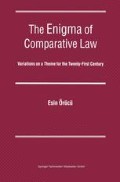Abstract
Comparative Law is an enigmatic, paradoxical and elusive subject in that, just as one thinks one has mastered it, another puzzle appears on the horizon. The puzzles start with the name of the subject, continue with its definition, aims, objectives, methodology and its use in practice, and culminate in its value and significance for legal science. Comparative law is at times in accord and at times in discord with other branches of law such as public international law, private international law and legal theory, and with other fields of study such as anthropology, sociology, history, philosophy and economics. It embodies harmony and disharmony, and syncopation. It is stimulating, yet routine. It is enabling, yet frustrating. It is poised to become the ‘science of tomorrow’, the tool for understanding laws and cultures in the globalizing world of the twenty-first century, and yet it is still not always taken seriously by many scholars. Its functions and malfunctions, conceptions and misconceptions, advantages and disadvantages are under perpetual discussion. This contested subject can only be approached as an enigma and the present study aims to do this.
Access this chapter
Tax calculation will be finalised at checkout
Purchases are for personal use only
Preview
Unable to display preview. Download preview PDF.
References
W. Twining, ‘Comparative Law and Legal Theory: the Country and Western Tradition’, in I.D. Edge (ed), Comparative Law in Global Perspective (New York, Transnational Publishers, 2000), p. 51.
D. Kennedy, The methods and the polities’, in P. Legrand and R. Munday (eds), Comparative Legal Studies: Traditions and Transitions (Cambridge, Cambridge University Press, 2002), pp. 345–433.
R. Cotterrel, ‘Seeking Similarity, Appreciating Difference: Comparative Law and Communities’, in A. Harding and E. Oriicu (eds), Comparative Law in the 21st Century (London, Kluwer Law International, 2002), p. 36.
B. Markesinis, Foreign Law and Comparative Methodology (Oxford, Hart Publishing, 1998), p. 36.
Twining, above note 1, at p. 47.
Enigma Variations’ by Sir Edward Elgar inspired the title of this work in the choice of the two words, ‘enigma’ and ‘variation’, but beyond that there is no relationship between this Enigma and variations and Elgar’s ’Enigma Variations’. ’Variations on an original theme, the Enigma’ was composed in 1899 as a set of 14 orchestral variations on an undisclosed theme. The ’original theme’ is said to represent Elgar himself, this being the ‘enigma’ of the title. The sub-enigma is ’another and larger theme’ which Elgar said ’goes’ through and over the whole set ’but is not played’. Through the eyes of the ’original’ theme, Elgar, the listener sees his wife and 12 of his friends, and Elgar in the finale. A third enigma lies in the asterisks of the 13th variation. If there had been a relationship between my work and that of Elgar’s, I would have taken all the comparative lawyers I know one by one and written a chapter on each titled with the initials of each!
Iam indebted to Aaron Copland for all musical references. See A. Copland, What to Listen for in Music, Revised ed. (New York, Toronto, London, McGraw-Hill Book Co., 1957)
Ibid., p. 162.
E. Orucii, Critical Comparative Law: Considering Paradoxes for Legal Systems in Transition (Deventer, Kluwer Law International, 1999) and also in (2000) 4 Electronic Journal of Comparative Law 2.
Copland above note 7, p. 25.
Ibid., p. 142.
Ibid., p. 143.
Here there are four possibilities. The first is where the melody is retained literally, but the accompanying harmonies are completely transformed; the second is where the texture becomes enriched though the melody is kept; the third is where the melody is lost but the underlying harmonic skeleton is kept; and in the extreme fourth case, the chordal skeleton itself is varied - thus it is not so much a variation of the theme as a variation of the accompanying chords of the theme.
Here there are three possibilities. The first is where the melody itself is varied, the outer contours are kept but the line is more florid; the second is where the melodic line becomes less florid by concentrating on the barest essential notes; and the third is where the theme is retained but its position is changed.
Here all types of rhythmic variations can be seen where the theme is completely transformed by rhythmic changes.
Here a simple type is achieved by adding a new theme to the original, retaining the original in the background.
For musical examples see Copland, above note 7, pp. 276–282.
Ibid. p. 151.
Ibid.
Ibid. p. 152.
Rights and permissions
Copyright information
© 2004 Springer Science+Business Media Dordrecht
About this chapter
Cite this chapter
Örücü, E. (2004). Overture. In: The Enigma of Comparative Law. Springer, Dordrecht. https://doi.org/10.1007/978-94-017-5596-2_1
Download citation
DOI: https://doi.org/10.1007/978-94-017-5596-2_1
Publisher Name: Springer, Dordrecht
Print ISBN: 978-90-04-13989-3
Online ISBN: 978-94-017-5596-2
eBook Packages: Springer Book Archive

